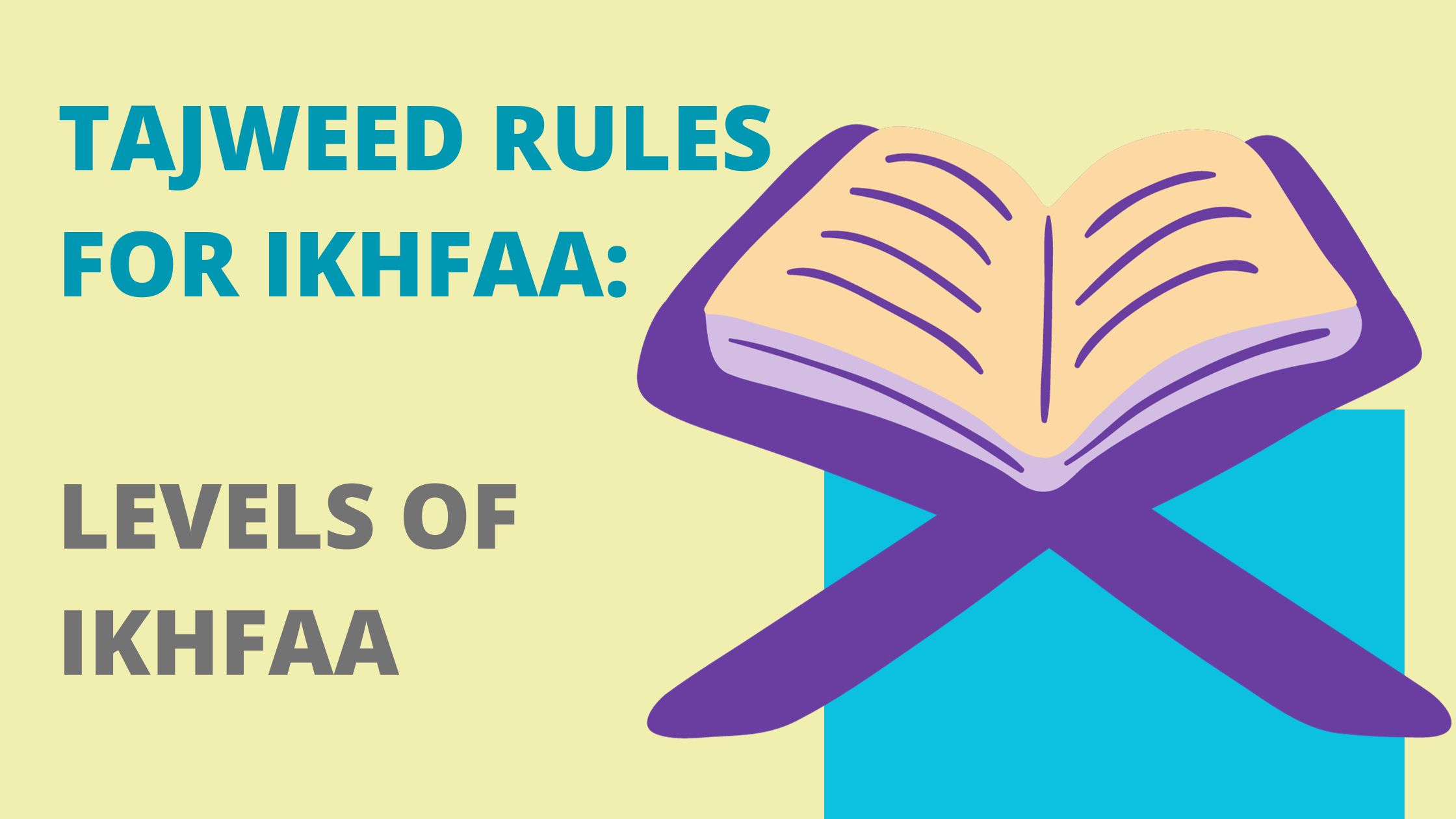In this article, we will delve into the definition of Ikhfaa, explore its various rules of Ikhfaa and levels, identify common mistakes to avoid, and provide examples from the Quran to help illustrate its application.
If you’re interested in learning about the art of proper Quran recitation, then understanding Ikhfaa is essential. Ikhfaa is a fundamental aspect of Tajweed that involves blending certain letters smoothly and subtly.
Table of Contents
Defining Ikhfaa in Tajweed
In Tajweed, Ikhfaa refers to the technique of smoothly blending certain sounds while reciting the Quran. It is used when transitioning from one letter to another, particularly when encountering the letter “Noon Sakinah” or “Tanween” between Izhaar and Idghaam.
The purpose of Ikhfaa is to conceal or hide the sound of a letter, like silent letters, while keeping the nasal sound clear.
In simpler terms, Ikhfaa involves hiding or partially concealing the pronunciation of a letter while still pronouncing it. It serves as a middle ground between the techniques of Izhaar (pronouncing clearly) and Idghaam (merging sounds).
Differentiating Between Ikhfaa Haqiqi And Ikhfaa Shafawi
There are two types of Ikhfaa in Tajweed: Ikfaa Haqiqi and Ikhfaa Shafawi. The difference between the two lies in their pronunciation:
1. Ikhfaa Haqiqi:
Ikhfaa Haqiqi, also known as clear Ikhfaa, involves concealing the sound of An-Noon As-Sakinah or At-Tanween when followed by one of the fifteen specific Arabic letters.
These fifteen letters are considered to have a clear and distinct hidden pronunciation. When any of these letters come after Noon Sakinah or Tanween, Ikhfaa Haqiqi is applied.
2. Ikhfaa Shafawi:
Ikhfaa Shafawi, also known as oral Ikhfaa, refers to hiding or concealing the sound of the Arabic letter Al-Meem As-Sakinah (م) when it is followed by the letter Baa (ب).
This technique is named Ikhfaa Shafawi because the letter Meem shares the same place of articulation (sound production) as the letter Baa, which is pronounced with the lips.
In summary, Ikhfaa Haqiqi involves hiding the sound of certain letters after Noon Sakinah or Tanween, while Ikhfaa Shafawi focuses on concealing the sound of Al-Meem As-Sakinah when followed by the letter Baa.
Remember to join us at Bayan Al-Quran Academy to deepen your knowledge about Tajweed and enhance your understanding of these important concepts!
Pronunciation of Ikhfaa Letters
The Ikhfaa letters refer to the fifteen Arabic letters that are part of the technique of Ikhfaa, which is used in Tajweed when reciting the Quran.
These letters include ك (Kaf), ق (Qaf), ف (Fa), ظ (Dhadh), ط (Taa), ض (Dhaad), ش (Sheen), س (Seen), ز (Zain), ذ (Tha), د (Dal), ج (Jeem), ث (Tha), ت (Ta). They are called Ikhfaa letters because they involve hiding or concealing the sound while pronouncing them.
Take advantage of online platforms like Bayan Al-Quran Academy to learn Tajweed effectively and gain proficiency in applying Ikhfaa rules while reciting this holy scripture.
Three Levels of Ikhfaa in Tajweed
In Tajweed, the concept of Ikhfaa, or the hiding or covering of certain sounds in recitation, has three distinct levels. These levels depend on the positions of articulation of the Arabic letter “Noon Sakinah” (silent noon) or the Arabic phonetic sign “Tanween” (a double vowel sound). Each level corresponds to specific Arabic letters and their positions of articulation.
1. The High Level of Al-Ikhfaa:
The high degree of Ikhfaa occurs when Noon Sakinah or Tanween Sign is followed by the Arabic letters (د ، ت ط). In this case, Ikhfaa is somewhat similar to Al-Idghaam because the positions of articulations (Makharaj) of these three Arabic letters are adjacent to the position of articulation (Maharaj) of Noon Sakinah or Tanween.
2. The Low Level of Al-Ikhfaa:
The low degree of Ikhfaa rule applies when the Noon Sakinah or Tanween Sign is followed by two Arabic letters, specifically (ق ، ك). Here, it is somewhat similar to the rule of Al-Izhaar because the places of articulation for these two Arabic letters are not close to the positions of articulation of Noon Sakinah or Tanween signs.
3. The In-Between Level of Al-Ikhfaa:
This level occurs when one of the other ten Arabic letters comes after Noon Sakinah or Tanween. It is characterized by positions of articulation that are neither remote nor adjacent to the positions of articulation of Noon Sakinah or Tanween.
Understanding these three levels of Ikhfaa in Tajweed is crucial for proper recitation of the Quran. By recognizing the specific circumstances where each level applies, learners can accurately apply the rules of Ikhfaa and refine their recitation skills.
Learn All about Madd:
Common Mistakes in Applying Ikhfaa (Shortly in bullet points)
When it comes to applying Ikhfaa in Tajweed, there are some common mistakes that learners often make. These mistakes can affect the proper pronunciation and understanding of the Quranic verses. Here are some of the common errors to watch out for:
1. Ghunnah Emphasis:
– Emphasizing the sound of Ghunnah, which can make Ikhfaa sound more like Idghaam.
2. Length of Ghunnah:
– Pronouncing the Ghunnah with a length that is longer than needed, exceeding the standard duration of two harakahs.
3. Failure to Apply Ikhfaa:
– Failing to apply Ikhfaa when Noon Sakinah or Tanween appears before any of the 15 Ikhfaa letters.
4. Mispronunciation of Ikhfaa Letters:
– Mispronouncing the Ikhfaa letters themselves, such as not producing the slight nasal sound correctly.
5. Lack of Differentiation between Levels:
– Neglecting to differentiate between the three levels of Ikhfaa and applying the wrong level in certain situations.
6. Lack of Understanding Articulation Positions:
– Not understanding the positions of articulation for the Ikhfaa letters and their relation to Noon Sakinah or Tanween.
7. Incorrect Application with Other Letters:
– Incorrectly applying Ikhfaa when other Arabic letters follow Noon Sakinah or Tanween, instead of recognizing the in-between degree of Ikhfaa.
8. Inadequate Practice and Mastery:
– Failing to practice and master the correct pronunciation of Ikhfaa, leading to inconsistencies in recitation.
To avoid these common mistakes, it is crucial to practice regularly with a qualified teacher who can guide you through each step of mastering Tajweed rules, including the Ikhfaa application.
Examples of Ikhfaa in the Quran
The Quran, being the ultimate source of guidance for Muslims, contains several examples of Ikhfaa. Let’s explore some instances where this Tajweed rule is applied:
1. Noon Sakinah Examples:
- Saad (ص ): The word “وَالْأَنْصارِ” has a Noon Sakinah at the end, followed by the letter Saad in the same word.
- Taa (ت): The word “أَنْ تَعْتَدُوا” has a Noon Sakinah at the end of the word “أَنْ”, followed by the letter Taa at the next word.
- Dhaal (ذ): The word “وأنذرهم” has a Noon Sakinah at the end of the verb, followed by the letter Dhaal in the same word.
2. Tanween Examples:
- Thaa (ث): The phrase “قَوْلًا ثَقِيلًا” has a Tanween at the end of the noun “قَوْلًا”, followed by the letter Thaa in the next word.
- Dhaal (ذ): The phrase “بسلامٍ ذلك” where the noun “بسلامٍ” has a Tanween at the end, followed by the letter Dhaal in the next word.
- Zaa (ز): The phrase “نفساً زكية” has a Tanween at the end of the noun “نفساً”, followed by the letter Zaa in the next word.
Refine Your Recitation Skills and Enhance Your Understanding of the Quran with Bayan Al-Quran Academy’s Tajweed Course
Take a step towards deepening your understanding and connection with the Quran by enrolling in Bayan Al-Quran Academy’s online Tajweed course for kids.
Whether you are a beginner or seeking to refine your recitation skills, our highly skilled tutors and flexible schedule will guide you on this transformative journey.
Experience the beauty of Quranic recitation and learn to pronounce Arabic correctly, all from the comfort of your own home. Join our Academy today and embark on a path of spiritual growth and proficiency in the noble art of Tajweed.
Note: Read The Difference between Ikhfa, Idgham, Izhar, and Iqlab in Tajweed.
Conclusion
Understanding the rules of Ikhfaa in Tajweed is crucial for proper recitation of the Quran. By mastering the pronunciation of the 15 letters that involve Ikhfaa and being able to identify Ikhfaa in the Quran, learners can enhance their recitation skills and connect with the divine words more effectively.
It is important to differentiate between Ikhfaa Haqiqi and Ikhfaa Shafawi, as well as be aware of common mistakes when applying Ikhfaa. Examples of Ikhfaa in the Quran serve as a guide for learners to improve their Tajweed.
To embark on this journey of learning Tajweed online with experts, consider joining Bayan Al-Quran Academy, where you will receive comprehensive guidance and support in your pursuit of mastering this beautiful art form.

















